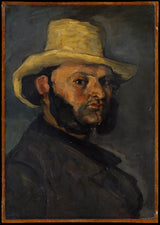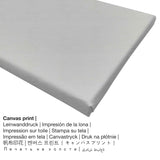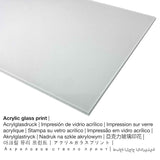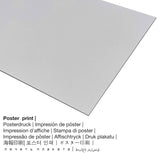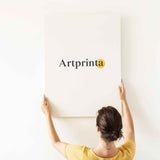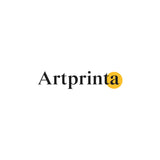Paul Cézanne, 1870 - Gustave Boyer (b. 1840) n'ime okpu Straw - mbipụta nka mara mma.
Ụtụ gụnyere. Mbupu gbakọrọ na ndenye ọpụpụ.
Nhọrọ akụrụngwa ngwaahịa gị
Maka mbipụta nka ọ bụla anyị na-enye ihe dị iche iche na nha. Ya mere, anyị na-enye gị ohere ịhọrọ n'ime nhọrọ ndị a:
- Glass acrylic e biri ebi (nwere ezigbo mkpuchi iko): The acrylic glass print, often named a plexiglass print, will transform your favorite original artwork into brilliant décor. With an acrylic glass fine art print contrasts and small painting details will be visible due to the subtle gradation.
- Mbipụta nke aluminom: Aluminium Dibond prints are prints on metal with an impressive depth. A non-reflective surface make a fashionable impression. The Aluminium Dibond Print is the excellent introduction to the sophisticated world of fine reproductions manufactured on aluminum. For your Print On Aluminum Dibond, we print your selected artpiece onto the aluminium surface. The white and bright sections of the work of art shimmer with a silky gloss, however without glare.
- Mbipụta kanvas: A canvas print, which should not be confused with a canvas painting, is a digital replica printed from an industrial printer. Furthermore, a printed canvas makes a attractive, appealing feeling. Your canvas print of this work of art will give you the unique chance to turn your into a large size work of art. Canvas prints are relatively low in weight, which means that it is easy to hang up your Canvas print without extra wall-mounts. Hence, a canvas print is suitable for any type of wall.
- Mpempe akwụkwọ ederede (akwa akwa akwa): A poster print is a printed flat canvas with a slightly rough surface texture. The print poster is appropriate for putting the art print in a customized frame. Please bear in mind, that depending on the absolute size of the canvas poster print we add a white margin of approximately 2-6cm round about the print to facilitate the framing with your custom frame.
Nkwupụta iwu: We try in order to depict our art products with as many details as possible and to showcase them visually on the different product detail pages. Nonetheless, the pigments of the print products and the printing can differ marginally from the representation on the device's monitor. Depending on your settings of your screen and the nature of the surface, color pigments might not be printed one hundret percent realistically. Considering that the art prints are printed and processed manually, there might as well be minor deviations in the size and exact position of the motif.
Ozi izizi gbasara nka sitere na The Metropolitan Museum of Art (© - Ụlọ ihe ngosi nka nke obodo ukwu - Museumlọ ihe ngosi nka nke Obodo)
Early twentieth-century scholars identified this man with mutton-chop sideburns as Cézanne himself, but he is actually the artist’s boyhood friend Gustave Boyer, a lawyer who sat for two other portraits around 1870–71. The painterly surface of this canvas, the liberal use of black and gray, and the boldly realized forms are typical of Cézanne’s work at the time.
What you should know this artpiece painted by Paul Cézanne
Gustave Boyer (b. 1840) in a Straw Hat bụ onye na-ese ihe nkiri kere ya Paul Cézanne in 1870. Ihe osise a tụrụ nha: 21 5/8 x 15 1/4 in (54,9 x 38,7 cm). Oil on paper, laid down on canvas was used by the French painter as the technique for the work of art. The work of art belongs to the collection of Museumlọ ihe ngosi nka nke Obodo. Site n'ikike nke: Ụlọ ihe ngosi nka nke Metropolitan, New York, HO Havemeyer mkpokọta, Arịrịọ nke Oriakụ HO Havemeyer, 1929 (nwere ikike: ngalaba ọha). Ihe kredit nke artpiece bụ: Mkpokọta HO Havemeyer, Arịrịọ nke Oriakụ HO Havemeyer, 1929. Ọzọkwa, nhazi nke mmepụta dijitalụ dị na eserese format ya na oke nke 1: 1.4, nke pụtara na ogologo bụ 29% mkpụmkpụ karịa obosara. Paul Cézanne was a male painter, whose art style was primarily Impressionism. The painter was born in the year 1839 na nwụrụ anwụ na afọ nke 67 N'afọ 1906 na Aix-en-Provence.
Iberibe nkọwa nka
| Aha nke ihe nka: | "Gustave Boyer (b. 1840) in a Straw Hat" |
| Nhazi nka nka: | sere |
| Okwu mkpokọta: | nkà nke oge a |
| Time: | 19th narị afọ |
| Afọ nka: | 1870 |
| Ogologo afọ nka nka: | ihe dị ka afọ 150 |
| Agba na: | mmanụ n'akwụkwọ, nke e debere na akwaaji |
| Akụkụ izizi (ọrụ nka): | 21 5/8 x 15 1/4 na (54,9 x 38,7 cm) |
| Ụlọ ihe ngosi nka / mkpokọta: | Museumlọ ihe ngosi nka nke Obodo |
| Ebe ngosi nka: | New York City, New York, Njikota Obodo Amerika |
| Weebụsaịtị ihe ngosi nka: | www.metmuseum.org |
| Licensedị ikike: | ngalaba ọha |
| Site n'aka: | Ụlọ ihe ngosi nka nke Metropolitan, New York, HO Havemeyer mkpokọta, Arịrịọ nke Oriakụ HO Havemeyer, 1929 |
| Ebe E Si Nweta: | Mkpokọta HO Havemeyer, Arịrịọ nke Oriakụ HO Havemeyer, 1929 |
Nkọwa ngwaahịa ahaziri ahazi
| Nkewa ngwaahịa: | ọrụ mgbidi |
| Usoro mmeputakwa: | mmeputakwa n'ụdị dijitalụ |
| Usoro mmepụta: | Mbipụta UV ozugbo (mbipụta dijitalụ) |
| Mmalite ngwaahịa: | emepụtara na Germany |
| Stockdị ngwaahịa: | mmepụta ihe na-achọ |
| A na-atụ aro iji ngwaahịa eme ihe: | ime ụlọ, ụlọ mmepụta nka nka |
| Ndozi onyonyo: | nhazi ihe osise |
| Oke akụkụ: | 1: 1.4 |
| Nkọwa: | ogologo bụ 29% mkpụmkpụ karịa obosara |
| Nhọrọ akwa: | ígwè ebipụta (aluminium dibond), acrylic glass print (nwere ezigbo mkpuchi iko), mbipụta akwụkwọ mmado (akwụkwọ kwaaji), akwụkwọ akwa akwa. |
| Nha n'arọwa n'elu ihe ndọtị (mbipụta akwa akwa): | 50x70cm - 20x28", 100x140cm - 39x55" |
| Mbipụta iko acrylic (nwere ezigbo mkpuchi iko) nhọrọ nha: | 50x70cm - 20x28", 100x140cm - 39x55" |
| Mbipụta akwụkwọ mmado (akwụkwọ kwaaji): | 50x70cm - 20x28" |
| Ụdị nha ebipụta aluminom: | 50x70cm - 20x28", 100x140cm - 39x55" |
| ụba: | na-enweghị etiti |
Ozi omenkà Contextal
| Ihe nkiri: | Paul Cézanne |
| Gender: | nwoke |
| Obodo onye nka: | French |
| Ọrụ: | onye na-ese ihe |
| Country: | France |
| nhazi ọkwa: | omenkà nke oge a |
| Ụdị nke onye na-ese ihe: | Mmetụta |
| Ndụ: | 67 afọ |
| Amụrụ n'afọ: | 1839 |
| Afọ nwụrụ: | 1906 |
| Nwuru na (ebe): | Aix na Provence |
© Nchekwa ikike nwebisiinka, Artprinta (www.artprinta.com)

